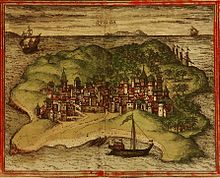This article needs additional citations for verification. (October 2016) |

The "Shirazi era" refers to a mythic origin in the history of Southeast Africa (and especially Tanzania), between the 13th century and 15th century, as recorded in the 15th century Kilwa Chronicle.[1] Many Swahili in the central coastal region claim that their towns were founded by Persians from the Shiraz region in the 13th century.[citation needed]
Population Genetics has identified the maternal heritage of the present and pre-modern population is principally of sub-saharan lineages, primarily Bantu and Pastoral Neolithic, while the majority of the male heritage, in the costal settlements, is of Asian origin, with Y-DNA haplogroups common to West Asia: J2, G2, and R1a most frequent in the samples, partially supporting the mythology.[2]
- ^ Wynne-Jones, Stephanie (2016-05-19). "Kilwa Kisiwani: Establishing a Town". doi:10.1093/oso/9780198759317.003.0008.
{{cite journal}}: Cite journal requires|journal=(help) - ^ Brielle, Esther S.; Fleisher, Jeffrey; Wynne-Jones, Stephanie; Sirak, Kendra; Broomandkhoshbacht, Nasreen; Callan, Kim; Curtis, Elizabeth; Iliev, Lora; Lawson, Ann Marie; Oppenheimer, Jonas; Qiu, Lijun; Stewardson, Kristin; Workman, J. Noah; Zalzala, Fatma; Ayodo, George (March 2023). "Entwined African and Asian genetic roots of medieval peoples of the Swahili coast". Nature. 615 (7954): 866–873. doi:10.1038/s41586-023-05754-w. ISSN 1476-4687. PMC 10060156.
© MMXXIII Rich X Search. We shall prevail. All rights reserved. Rich X Search
